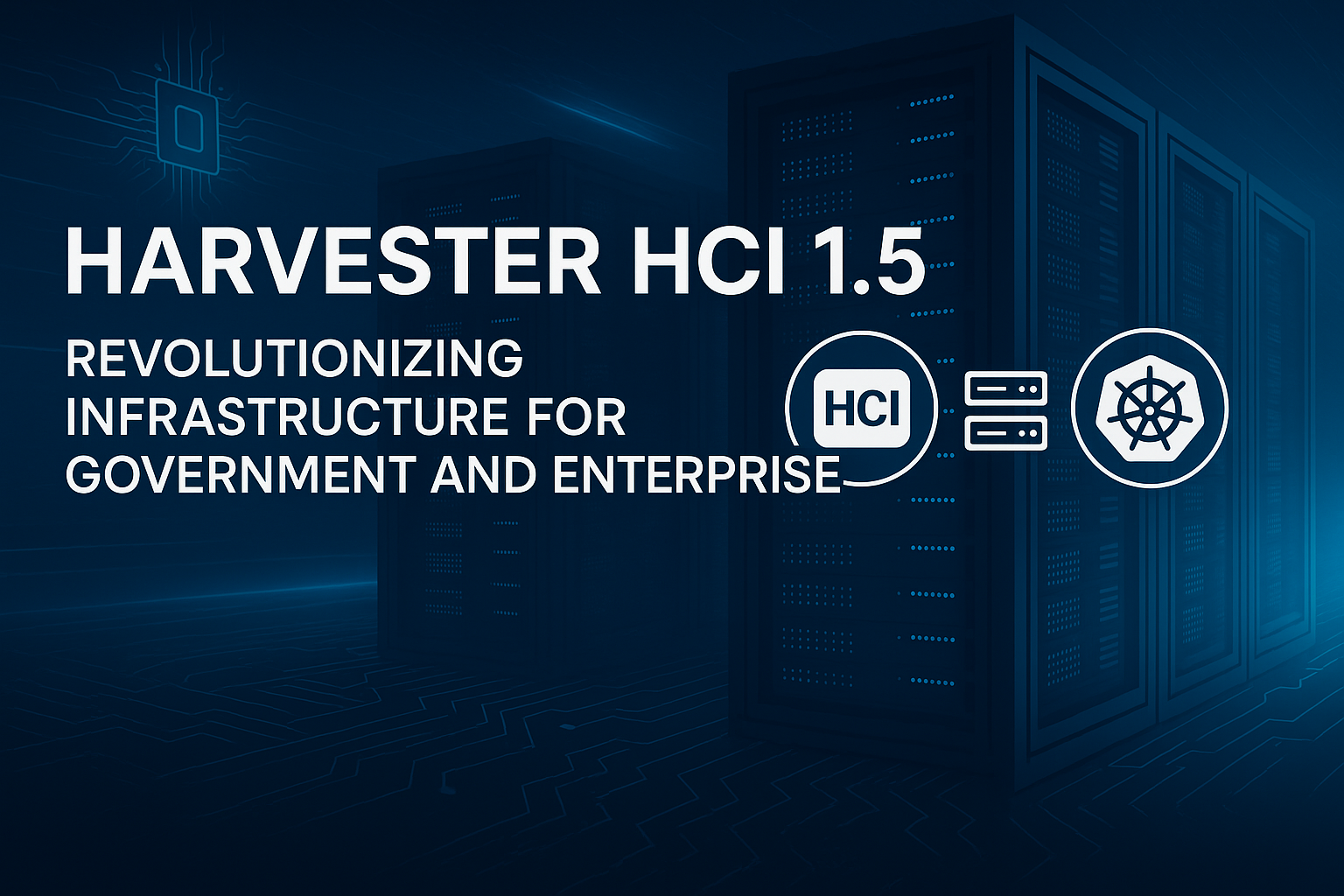Harvester HCI 1.5: Revolutionizing Infrastructure for Government and Enterprise
Harvester HCI 1.5 isn’t just an upgrade—it’s a full-blown infrastructure renaissance for government and enterprise IT.

The landscape of hyperconverged infrastructure is experiencing a transformative shift as organizations seek alternatives to expensive, proprietary solutions. Harvester HCI has emerged as a game-changing open-source platform that promises to deliver enterprise-grade capabilities while eliminating the cost burdens associated with traditional HCI systems. With the recent release of version 1.5, Harvester has positioned itself as a compelling solution for Department of Defense (DoD), government agencies, and commercial enterprises looking to modernize their infrastructure while maintaining strict control over costs and security.
Understanding the Traditional HCI Landscape and Its Limitations
Hyperconverged infrastructure represents a fundamental shift from traditional data center architectures by integrating compute, storage, virtualization, and networking into unified, software-defined systems. While HCI solutions have simplified data center management and improved scalability, they have historically come with significant drawbacks that particularly impact government and cost-conscious organizations. Traditional HCI platforms like VMware vSAN and Nutanix have dominated the market through proprietary solutions that require substantial licensing investments and often create vendor lock-in scenarios.
The challenges with conventional HCI systems extend beyond initial costs. Legacy systems often lack cloud-native capabilities, creating bottlenecks for organizations striving to remain agile and responsive. These systems frequently lead to escalating operational costs, limited flexibility, and forced obsolescence, all of which compromise scalability, interoperability, and organizational agility. For government entities, these limitations are particularly problematic given budget constraints and the need for long-term infrastructure stability. The acquisition of VMware by Broadcom has introduced additional uncertainties around functionality, procurement paths, and pricing, further complicating the landscape for organizations dependent on these solutions.
Traditional virtualization environments like ESXi and Proxmox represent more conventional approaches that separate compute, storage, and networking components. While this separation can provide optimal performance through specialized hardware, it often results in increased complexity and higher management overhead. These platforms typically require significant expertise to manage at scale and can become cost-prohibitive when factoring in licensing, support, and specialized hardware requirements. The complexity of managing disparate systems creates operational burdens that many organizations struggle to maintain with limited IT resources.
Harvester HCI: A Modern Cloud-Native Alternative
Harvester HCI represents a paradigm shift in infrastructure design, built from the ground up as a modern, open, and interoperable hyperconverged infrastructure solution. At its core, Harvester leverages Kubernetes as the foundational orchestration platform, incorporating cutting-edge open-source technologies including Linux OS, KubeVirt for virtualization management, and Longhorn for distributed storage. This architecture creates a unified platform capable of managing both virtual machines and containerized workloads through a single management interface.
The platform's design philosophy centers on simplicity and enterprise readiness. Harvester ships as a bootable appliance image that can be installed directly on bare metal servers using ISO images or automated iPXE scripts. This approach eliminates the complexity typically associated with HCI deployments while providing immediate access to advanced features including VM lifecycle management, live migration support, distributed storage, and comprehensive network management capabilities. The integration with Rancher further enhances its value proposition by providing centralized management capabilities across multiple clusters and environments.
Harvester's architecture leverages local, directly-attached storage instead of complex external SANs, significantly reducing infrastructure complexity and costs. The platform utilizes the Kubernetes API as a unified automation language across both container and VM workloads, creating consistency in management and operations. This approach enables organizations to modernize their infrastructure incrementally, supporting both legacy virtualized applications and modern cloud-native workloads within the same platform. The seamless integration of these capabilities makes Harvester particularly attractive for organizations transitioning from traditional virtualization environments to more modern, flexible infrastructure models.
Revolutionary Improvements in Harvester 1.5
The release of Harvester 1.5 marks a significant milestone in the platform's evolution, introducing capabilities that dramatically expand its applicability and performance characteristics. The most notable advancement is the general availability of ARM64 support, which unlocks new deployment possibilities across edge, laboratory, and data center environments. This ARM64 support enables organizations to leverage more cost-effective and power-efficient hardware options, particularly valuable for edge computing scenarios and environments with power constraints. The native ARM virtualization capabilities eliminate the need for emulation, providing optimal performance on ARM-based infrastructure.
Perhaps the most transformative feature in version 1.5 is the introduction of external CSI (Container Storage Interface) driver support for provisioning both root and data volumes. This capability represents a fundamental shift from previous versions that were coupled exclusively with Longhorn storage. Organizations can now integrate enterprise SAN/NAS systems, Ceph, OpenEBS, and other open-source storage stacks, as well as hardware-optimized or zone-aware storage backends. This flexibility enables infrastructure teams to align Harvester with existing investments and specific performance requirements while maintaining the platform's ease of use and management benefits.
Version 1.5 also introduces significant enhancements to the Longhorn V2 Data Engine, enabling users to create virtual machine images and boot volumes with improved performance characteristics. The platform now supports live migration of virtual machines with attached V2 volumes, ensuring zero-downtime operations during maintenance and scaling activities. These improvements, combined with enhanced monitoring capabilities through integrated Grafana and Prometheus solutions, position Harvester 1.5 as a comprehensive infrastructure platform capable of meeting enterprise-grade requirements. The release also includes security enhancements and optimizations that make it particularly suitable for government and regulated environments.
Transforming Government and DoD Operations
For government agencies and Department of Defense organizations, Harvester HCI presents unprecedented opportunities to modernize infrastructure while maintaining security and compliance requirements. The development of Harvester Government specifically addresses the unique needs of federal and military environments through a hardened, compliance-ready platform. This specialized version embodies a commitment to delivering secure-by-design solutions in collaboration with the Cybersecurity and Infrastructure Security Agency (CISA), providing out-of-the-box FIPS and STIG compliance.
The government sector's adoption of Harvester addresses several critical challenges inherent in traditional infrastructure approaches. Legacy systems often require extensive customization and ongoing maintenance to meet security standards, creating significant operational overhead. Harvester Government eliminates these challenges by providing a fully compliant, secure infrastructure that can be deployed within hours rather than weeks. This rapid deployment capability is particularly valuable for military operations and government agencies that need to establish infrastructure quickly in various environments, including disconnected or low-bandwidth scenarios.
The platform's edge-ready flexibility makes it ideal for government applications that require distributed computing capabilities. Military installations, remote government facilities, and tactical environments benefit from Harvester's ability to operate effectively in challenging conditions while maintaining centralized management capabilities. The integration with Rancher provides unified management across multiple deployments, enabling government IT teams to maintain oversight and control across geographically dispersed installations. This centralized management capability is enhanced by 24/7 support from U.S.-based, security-cleared professionals who understand the unique challenges and mission requirements of government operations.
Government organizations also benefit from Harvester's future-proof architecture that seamlessly integrates legacy virtualized infrastructure while enabling adoption of modern containerized applications. This capability is crucial for government agencies that must maintain existing systems while gradually modernizing their application portfolios. The platform's ability to run both virtual machines and containers under unified management eliminates the need for separate infrastructure stacks, reducing complexity and operational costs. For agencies operating under strict budget constraints, this consolidation represents significant value through reduced hardware requirements, simplified management, and eliminated licensing costs.
Commercial Enterprise Advantages and Use Cases
Commercial enterprises across various industries are discovering Harvester's potential to transform their infrastructure economics and operational efficiency. The platform's 100% open-source nature eliminates the substantial licensing fees associated with proprietary HCI solutions, creating immediate cost advantages that compound over time. Organizations report significant reductions in total cost of ownership (TCO) through elimination of vendor lock-in scenarios and reduced dependency on specialized hardware. This cost structure enables enterprises to allocate resources previously dedicated to licensing toward innovation and growth initiatives.
The manufacturing sector particularly benefits from Harvester's edge computing capabilities, where production lines increasingly require intelligent systems for sensor data processing and real-time decision making. Modern manufacturing environments generate substantial sensor data that requires local processing to enable sub-five-millisecond response times for critical control systems. Harvester's ability to deploy ruggedized infrastructure that withstands high temperatures, low temperatures, and harsh environmental conditions makes it ideal for these industrial applications. The platform's distributed storage and networking capabilities ensure high availability and resilience in mission-critical manufacturing scenarios.
Financial services and healthcare organizations leverage Harvester's security features and compliance capabilities to meet regulatory requirements while reducing infrastructure costs. The platform's integration with enterprise storage systems through CSI drivers enables these organizations to maintain existing investments in specialized storage infrastructure while modernizing their virtualization layer. The ability to manage both legacy applications and modern microservices within a single platform facilitates gradual digital transformation initiatives without disrupting critical business operations. This flexibility is particularly valuable for organizations with complex application portfolios that must maintain legacy systems while developing new cloud-native capabilities.
Retail and logistics companies benefit from Harvester's scalability and management simplicity, particularly for distributed operations across multiple locations. The platform's ability to operate effectively in branch office environments with minimal local IT support makes it ideal for retail chains and distribution networks. Centralized management through Rancher enables IT teams to maintain control and consistency across hundreds of locations while reducing the complexity and cost of local infrastructure management. These organizations also benefit from the platform's image recognition capabilities for security and inventory management applications, enhancing operational efficiency while reducing labor costs.
Comprehensive Cost Analysis and ROI Implications
The financial advantages of Harvester HCI extend far beyond the elimination of licensing fees, creating a comprehensive value proposition that impacts multiple aspects of infrastructure economics. Organizations implementing Harvester report substantial reductions in both capital and operational expenditures through several key mechanisms. The elimination of proprietary licensing fees represents the most immediate savings, with some organizations avoiding hundreds of thousands of dollars in annual license costs depending on their scale. This cost avoidance becomes more significant as organizations scale, creating compounding savings over time.
Hardware cost reductions represent another significant value driver, as Harvester's efficient resource allocation and ability to leverage commodity hardware reduces overall infrastructure requirements. The platform's local storage approach eliminates the need for expensive external SANs, reducing both initial capital investment and ongoing maintenance costs. Organizations can utilize high-density hardware configurations with local storage, maximizing rack space efficiency while minimizing equipment costs. The platform's support for ARM64 architecture in version 1.5 opens additional opportunities for cost reduction through more energy-efficient hardware options.
Operational cost savings emerge through simplified management and reduced staffing requirements. Harvester's unified management interface for both virtual machines and containers eliminates the need for separate specialized teams and reduces training requirements. The platform's automation capabilities and Kubernetes-native design enable organizations to implement infrastructure-as-code practices, reducing manual intervention and human error. These operational efficiencies are particularly valuable for organizations with limited IT resources or those operating across multiple geographic locations where specialized expertise may be scarce.
Independent analyses suggest that organizations implementing modern HCI solutions like Harvester can achieve return on investment (ROI) exceeding 258% through combination of cost reductions and operational improvements. This ROI is driven by factors including reduced downtime through improved reliability, faster deployment times enabling quicker time-to-market for new services, and improved resource utilization through better capacity planning and allocation. The platform's integration capabilities also create value through improved developer productivity and reduced complexity in application deployment and management. For government organizations, these benefits are amplified by the platform's compliance readiness, which eliminates the substantial costs typically associated with achieving and maintaining security certifications.
Future-Proofing Through Cloud-Native Architecture
Harvester's foundation on cloud-native technologies positions organizations for long-term success as the infrastructure industry continues its evolution toward containerized and edge computing models. The platform's Kubernetes-native architecture ensures compatibility with emerging cloud-native tools and practices, enabling organizations to adopt new technologies without requiring infrastructure replacement. This future-proofing capability is particularly valuable for government and enterprise organizations that need infrastructure investments to remain viable for extended periods.
The platform's modular architecture and open-source foundation enable continuous improvement and feature addition without vendor dependency. Organizations benefit from community-driven development and the ability to customize capabilities to meet specific requirements. This flexibility contrasts sharply with proprietary solutions that require vendor cooperation for feature development and may become obsolete when vendors change strategic direction. Harvester's integration with the Cloud Native Computing Foundation (CNCF) ecosystem ensures ongoing compatibility with emerging standards and technologies.
Version 1.5's enhanced storage capabilities through CSI driver support exemplify this future-proofing approach by enabling integration with emerging storage technologies as they become available. Organizations can evolve their storage strategies over time without requiring platform migration, protecting their infrastructure investments while enabling performance and capability improvements. This adaptability extends to networking, compute, and security domains, where Harvester's open architecture enables integration with best-of-breed solutions as organizational needs evolve.
How Does This Help Us?
Harvester HCI 1.5 represents a transformative opportunity for organizations seeking to modernize their infrastructure while controlling costs and maintaining operational flexibility. The platform's open-source foundation, cloud-native architecture, and comprehensive feature set create compelling advantages over traditional HCI solutions, particularly for government agencies and cost-conscious enterprises. The introduction of ARM64 support and external storage integration in version 1.5 significantly expands the platform's applicability while maintaining its core advantages of simplicity, security, and cost-effectiveness.
For government organizations, Harvester Government provides a secure-by-design solution that addresses compliance requirements while enabling rapid deployment and centralized management capabilities. Commercial enterprises benefit from substantial cost reductions, operational simplification, and future-proofing capabilities that support long-term digital transformation initiatives. The platform's ability to unify virtual machine and container workloads creates operational efficiencies that compound over time, delivering measurable return on investment through reduced licensing costs, improved resource utilization, and simplified management.
As organizations continue to evaluate alternatives to expensive proprietary solutions, Harvester HCI 1.5 stands out as a mature, capable platform that delivers enterprise-grade capabilities without the associated costs and vendor lock-in concerns. The platform's continued evolution and strong community support ensure that early adopters will benefit from ongoing improvements and feature additions, making Harvester an intelligent choice for organizations seeking sustainable, cost-effective infrastructure solutions that can adapt to future requirements and technologies.
AlphaBravo: https://alphabravo.io
Rancher Government Solutions: https://ranchergovernment.com/
Harvester HCI: https://harvesterhci.io/

